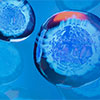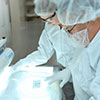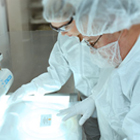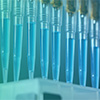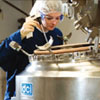Ace+Method+Development+Kits
Numéro de catalogue:
(BOSSBS-5511R-A750)
Fournisseur:
Bioss
Description:
This gene encodes a 105 kD protein which can undergo cotranslational processing by the 26S proteasome to produce a 50 kD protein. The 105 kD protein is a Rel protein-specific transcription inhibitor and the 50 kD protein is a DNA binding subunit of the NF-kappa-B (NFKB) protein complex. NFKB is a transcription regulator that is activated by various intra- and extra-cellular stimuli such as cytokines, oxidant-free radicals, ultraviolet irradiation, and bacterial or viral products. Activated NFKB translocates into the nucleus and stimulates the expression of genes involved in a wide variety of biological functions. Inappropriate activation of NFKB has been associated with a number of inflammatory diseases while persistent inhibition of NFKB leads to inappropriate immune cell development or delayed cell growth. Two transcript variants encoding different isoforms have been found for this gene.
UOM:
1 * 100 µl
Numéro de catalogue:
(BOSSBS-5511R-A680)
Fournisseur:
Bioss
Description:
This gene encodes a 105 kD protein which can undergo cotranslational processing by the 26S proteasome to produce a 50 kD protein. The 105 kD protein is a Rel protein-specific transcription inhibitor and the 50 kD protein is a DNA binding subunit of the NF-kappa-B (NFKB) protein complex. NFKB is a transcription regulator that is activated by various intra- and extra-cellular stimuli such as cytokines, oxidant-free radicals, ultraviolet irradiation, and bacterial or viral products. Activated NFKB translocates into the nucleus and stimulates the expression of genes involved in a wide variety of biological functions. Inappropriate activation of NFKB has been associated with a number of inflammatory diseases while persistent inhibition of NFKB leads to inappropriate immune cell development or delayed cell growth. Two transcript variants encoding different isoforms have been found for this gene.
UOM:
1 * 100 µl
Numéro de catalogue:
(BOSSBS-15343R-A350)
Fournisseur:
Bioss
Description:
C9orf79 is a 1445 amino acid single-pass membrane protein that belongs to the FAM75 family. The gene encoding C9orf79 maps to human chromosome 9, which consists of about 145 million bases and 4% of the human genome and encodes nearly 900 genes. Considered to play a role in gender determination, deletion of the distal portion of 9p can lead to development of male to female sex reversal, the phenotype of a female with a male X,Y genotype. Hereditary hemorrhagic telangiectasia, which is characterised by harmful vascular defects, is associated with the chromosome 9 gene encoding endoglin protein, ENG. Familial dysautonomia is also associated with chromosome 9 though through the gene IKBKAP. Notably, chromosome 9 encompasses the largest interferon family gene cluster. Chromosome 9 is partnered with chromosome 22 in the translocation leading to the aberrant production of BCR-ABL fusion protein often found in leukemias.
UOM:
1 * 100 µl
Numéro de catalogue:
(BOSSBS-15343R-A647)
Fournisseur:
Bioss
Description:
C9orf79 is a 1445 amino acid single-pass membrane protein that belongs to the FAM75 family. The gene encoding C9orf79 maps to human chromosome 9, which consists of about 145 million bases and 4% of the human genome and encodes nearly 900 genes. Considered to play a role in gender determination, deletion of the distal portion of 9p can lead to development of male to female sex reversal, the phenotype of a female with a male X,Y genotype. Hereditary hemorrhagic telangiectasia, which is characterised by harmful vascular defects, is associated with the chromosome 9 gene encoding endoglin protein, ENG. Familial dysautonomia is also associated with chromosome 9 though through the gene IKBKAP. Notably, chromosome 9 encompasses the largest interferon family gene cluster. Chromosome 9 is partnered with chromosome 22 in the translocation leading to the aberrant production of BCR-ABL fusion protein often found in leukemias.
UOM:
1 * 100 µl
Numéro de catalogue:
(BNUM0197-50)
Fournisseur:
Biotium
Description:
Recognizes a protein of 47-55 kDa, which is identified as FOXP3. Its precise epitope is not known, but it has been mapped to the N-terminal portion of the protein. The FOX family of transcription factors is a large group of proteins that share a common DNA binding domain termed a winged-helix or forkhead domain. During early development, FOXP1 and FOXP2 are expressed abundantly in the lung, with lower levels of expression in neural, intestinal and cardiovascular tissues, where they act as transcription repressors. FOXP1 is widely expressed in adult tissues, while neoplastic cells often exhibit a dramatic change in expression level or localization of FOXP1. Mutations in FOXP3 gene cause IPEX, a fatal, X-linked inherited disorder characterized by immune dysregulation. The FOXP3 protein is essential for normal immune homeostasis. Specifically, FOXP3 represses transcription through a DNA binding forkhead domain, thereby regulating T cell activation.
UOM:
1 * 50 µl
Numéro de catalogue:
(BOSSBS-12124R-A555)
Fournisseur:
Bioss
Description:
The GAT1 gene family includes sodium- and chloride-dependent plasma membrane transporters for neurotransmitters, metabolites and osmolites, which couple substrate flux to transmembrane electrochemical gradients. PROT (Sodium-dependent proline transporter), also known as Solute carrier family 6 member 7, is a 636 amino acid multi-pass membrane protein that is a GAT1 family member specifically expressed in regions of the brain. PROT terminates the action of proline by its high affinity sodium/chloride-dependent reuptake into pre-synaptic terminals. Enriched in glutamatergic synaptic terminals, it is likely that PROT plays an important role in excitatory events of neurotransmission. PROT-mediated proline uptake is inhibited by compounds such as benztropine, LP-403812 and Des-Tyr-Leu-enkephalin (GGFL). These inhibitors of proline uptake may lead to the development of therapeutic agents for certain neurologic disorders.
UOM:
1 * 100 µl
Numéro de catalogue:
(BOSSBS-9617R-A750)
Fournisseur:
Bioss
Description:
C14orf174, is a 674 amino acid protein that contains one SAM (sterile alpha motif) domain. Existing as two alternatively spliced isoforms, C14orf174 is encoded by a gene that maps to human chromosome 14q24.3. Chromosome 14 contains about 700 genes and 106 million base pairs and makes up about 3.5% of human cellular DNA. Chromosome 14 encodes the presinilin 1 (PSEN1) gene, which is one of the three key genes associated with the development of Alzheimer's disease. The SERPINA1 gene is located on chromosome 14 and when defective leads to the genetic disorder antitrypsin deficiency. This disorder is characterised by severe lung complications and liver dysfunction. Notably, the immunoglobulin heavy chain locus is found on chromosome 14 and has been identified as a fusion with the chromosome 19 encoded protein Bcl-3 in the (14;19) translocations found in a variety of B cell malignancies.
UOM:
1 * 100 µl
Numéro de catalogue:
(BOSSBS-15312R-A350)
Fournisseur:
Bioss
Description:
C9orf135 (chromosome 9 open reading frame 135) is a 229 amino acid single-pass membrane protein encoded by a gene that maps to human chromosome 9q21.11. Chromosome 9 consists of about 145 million bases, represents 4% of the human genome and encodes nearly 900 genes. Thought to play a role in gender determination, deletion of the distal portion of 9p can lead to development of male to female sex reversal, the phenotype of a female with a male X,Y genotype. Hereditary hemorrhagic telangiectasia, which is characterised by harmful vascular defects, is associated with the chromosome 9 gene encoding endoglin protein, ENG. Familial dysautonomia is also associated with chromosome 9 though through the gene IKBKAP. Notably, chromosome 9 encompasses the largest interferon family gene cluster. Chromosome 9 is partnered with chromosome 22 in the translocation leading to the aberrant production of BCR-ABL fusion protein often found in leukemias.
UOM:
1 * 100 µl
Numéro de catalogue:
(BOSSBS-9617R-CY5)
Fournisseur:
Bioss
Description:
C14orf174, is a 674 amino acid protein that contains one SAM (sterile alpha motif) domain. Existing as two alternatively spliced isoforms,C14orf174 is encoded by a gene that maps to human chromosome 14q24.3. Chromosome 14 contains about 700 genes and 106 million base pairs and makes up about 3.5% of human cellular DNA. Chromosome 14 encodes the presinilin 1 (PSEN1) gene, which is one of the three key genes associated with the development of Alzheimer's disease. The SERPINA1 gene is located on chromosome 14 and when defective leads to the genetic disorder ?-antitrypsin deficiency. This disorder is characterized by severe lung complications and liver dysfunction. Notably, the immunoglobulin heavy chain locus is found on chromosome 14 and has been identified as a fusion with the chromosome 19 encoded protein Bcl-3 in the (14;19) translocations found in a variety of B cell malignancies.
UOM:
1 * 100 µl
Numéro de catalogue:
(BOSSBS-9063R-FITC)
Fournisseur:
Bioss
Description:
Made up of nearly 146 million bases, chromosome 8 encodes about 800 genes. Translocation of portions of chromosome 8 with amplifications of the c-Myc gene are found in some leukemias and lymphomas, and typically associated with a poor prognosis. Portions of chromosome 8 have been linked to schizophrenia and bipolar disorder. Trisomy 8, also known as Warkany syndrome 2, most often results in early miscarriage but is occasionally seen in a mosaic form in surviving patients who suffer to a varying degree from a number of symptoms including retarded mental and motor development, and certain facial and developmental defects. WRN is a DNA helicase encoded by chromosome 8 and shown defective in those with the early aging disorder Werner syndrome. Chromosome 8 is also associated with Pfeiffer syndrome, congenital hypothyroidism and Waardenburg syndrome. The FAM135B gene product has been provisionally designated FAM135B pending further characterization.
UOM:
1 * 100 µl
Numéro de catalogue:
(BOSSBS-13522R-CY5)
Fournisseur:
Bioss
Description:
G protein-coupled receptors (GPRs or GPCRs), also known as seven transmembrane receptors, heptahelical receptors, or 7TM receptors, are members of the largest protein family and play a role in many different stimulus-response pathways. G-protein coupled receptors mediate extracellular signals into intracellular signals (G-protein activation). They respond to a great variety of signaling molecules, including hormones, neurotransmitters and other proteins and peptides. GPR proteins are integral seven-pass membrane proteins with some conserved amino acid regions. GPR19, an orphan receptor, shows elevated expression during embyronic development of the nervous sytem as well as in specific regions of adult mouse brain, including the olfactory bulb, the hippocampus, hypothalamic nuclei and the cerebellum. The GPR19 gene maps to a location on chromosome 12, which is a frequent target for rearrangement in cancer cells and involved in childhood acute lymphoblastic leukemia (ALL).
UOM:
1 * 100 µl
Numéro de catalogue:
(BOSSBS-15348R-CY5)
Fournisseur:
Bioss
Description:
Chromosome 9 consists of about 145 million bases and 4% of the human genome and encodes nearly 900 genes. Considered to play a role in gender determination, deletion of the distal portion of 9p can lead to development of male to female sex reversal, the phenotype of a female with a male X,Y genotype. Hereditary hemorrhagic telangiectasia, which is characterised by harmful vascular defects, is associated with the chromosome 9 gene encoding endoglin protein, ENG. Familial dysautonomia is also associated with chromosome 9 though through the gene IKBKAP. Notably, chromosome 9 encompasses the largest interferon family gene cluster. Chromosome 9 is partnered with chromosome 22 in the translocation leading to the aberrant production of BCR-ABL fusion protein often found in leukemias. The C9orf93 gene product has been provisionally designated C9orf93 pending further characterisation. There are two isoforms of C9orf93 that are produced as a result of alternative splicing events.
UOM:
1 * 100 µl
Numéro de catalogue:
(BOSSBS-15344R-FITC)
Fournisseur:
Bioss
Description:
Chromosome 9 consists of about 145 million bases and 4% of the human genome and encodes nearly 900 genes. Considered to play a role in gender determination, deletion of the distal portion of 9p can lead to development of male to female sex reversal, the phenotype of a female with a male X,Y genotype. Hereditary hemorrhagic telangiectasia, which is characterised by harmful vascular defects, is associated with the chromosome 9 gene encoding endoglin protein, ENG. Familial dysautonomia is also associated with chromosome 9 though through the gene IKBKAP. Notably, chromosome 9 encompasses the largest interferon family gene cluster. Chromosome 9 is partnered with chromosome 22 in the translocation leading to the aberrant production of BCR-ABL fusion protein often found in leukemias. The C9orf84 gene product has been provisionally designated C9orf84 pending further characterisation. There are two isoforms of C9orf84 that are produced as a result of alternative splicing events.
UOM:
1 * 100 µl
Numéro de catalogue:
(BOSSBS-2727R-HRP)
Fournisseur:
Bioss
Description:
TSLPR is a type I membrane receptor that forms a functional heterodimeric complex with IL7R to bind TSLP. The TSLP R contains a WSXWS motif required for proper protein folding and a box1 motif important for association with the JAKs. TSLPR has a predicted molecular weight approximately 41 kD, and two further isoforms have been reported that are produced by alternative splicing. The TSLPR is expressed preferentially in myeloid cells including dendritic cells and activated monocytes, and is weakly expressed in T cells. Expression has also been reported in heart, skeletal muscle, and kidney tissues. TSLP binding to the heterodimeric functional receptor (TSLPR and IL7R) activates JAK2, STAT3 and STAT5 to stimulate cell proliferation. Ligand receptor interactions haves been implicated in the development of the hematopoietic system, dendritic cell maturation, and the maintenance and polarization of human Th2 memory T cells in allergic diseases.
UOM:
1 * 100 µl
Numéro de catalogue:
(BOSSBS-15347R-HRP)
Fournisseur:
Bioss
Description:
Chromosome 9 consists of about 145 million bases and 4% of the human genome and encodes nearly 900 genes. Considered to play a role in gender determination, deletion of the distal portion of 9p can lead to development of male to female sex reversal, the phenotype of a female with a male X,Y genotype. Hereditary hemorrhagic telangiectasia, which is characterised by harmful vascular defects, is associated with the chromosome 9 gene encoding endoglin protein, ENG. Familial dysautonomia is also associated with chromosome 9 though through the gene IKBKAP. Notably, chromosome 9 encompasses the largest interferon family gene cluster. Chromosome 9 is partnered with chromosome 22 in the translocation leading to the aberrant production of BCR-ABL fusion protein often found in leukemias. The C9orf91 gene product has been provisionally designated C9orf91 pending further characterisation. There are three isoforms of C9orf91 that are produced as a result of alternative splicing events.
UOM:
1 * 100 µl
Numéro de catalogue:
(BOSSBS-15322R-CY3)
Fournisseur:
Bioss
Description:
C9orf21 (chromosome 9 open reading frame 21) is a 226 amino acid protein that belongs to the UPF0308 family and is encoded by a gene that maps to human chromosome 9q22.33. Chromosome 9 consists of about 145 million bases, represents 4% of the human genome and encodes nearly 900 genes. Thought to play a role in gender determination, deletion of the distal portion of 9p can lead to development of male to female sex reversal, the phenotype of a female with a male X,Y genotype. Hereditary hemorrhagic telangiectasia, which is characterised by harmful vascular defects, is associated with the chromosome 9 gene encoding endoglin protein, ENG. Familial dysautonomia is also associated with chromosome 9 though through the gene IKBKAP. Notably, chromosome 9 encompasses the largest interferon family gene cluster. Chromosome 9 is partnered with chromosome 22 in the translocation leading to the aberrant production of BCR-ABL fusion protein often found in leukemias.
UOM:
1 * 100 µl
Appel de prix
Le stock de cet article est limité mais peut être disponible dans un entrepôt proche de vous. Merci de vous assurer que vous êtes connecté sur le site afin que le stock disponible soit affiché. Si l'
Le stock de cet article est limité mais peut être disponible dans un entrepôt proche de vous. Merci de vous assurer que vous êtes connecté sur le site afin que le stock disponible soit affiché. Si l'
Ces articles ne peuvent être ajoutés au Panier. Veuillez contacter votre service client ou envoyer un e-mail à vwr.be@vwr.com
Une documentation supplémentaire peut être nécessaire pour l'achat de cet article. Un représentant de VWR vous contactera si nécessaire.
Ce produit a été bloqué par votre organisation. Contacter votre service d'achat pour plus d'informations.
Le produit original n'est plus disponible. Le remplacement représenté est disponible
Les produits marqués de ce symbole ne seront bientôt plus disponibles - vente jusqu'à épuisement de stock. Des alternatives peuvent être disponibles en recherchant le code article VWR indiqué ci-dessus. Si vous avez besoin d'une assistance supplémentaire, veuillez contacter notre Service Clientèle au 016 385 011.
|
|||||||||




